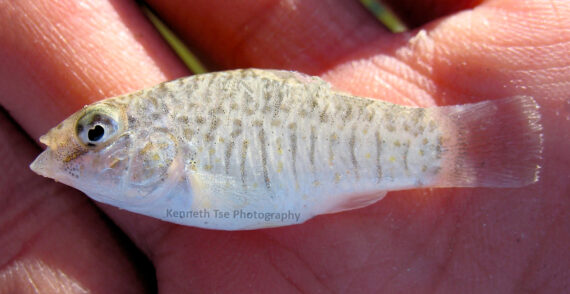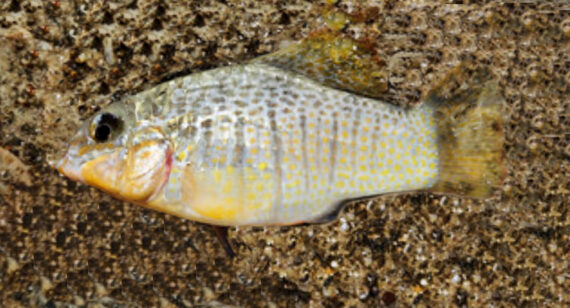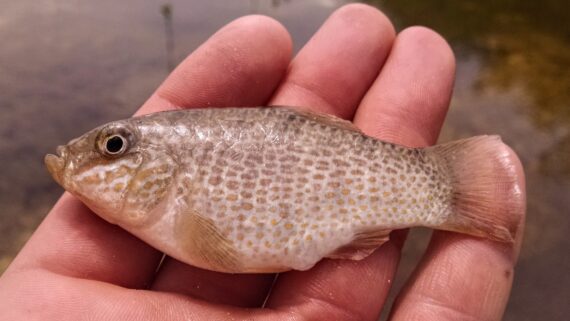Ocellated Killifish, Floridichthys polyommus
 Ocellated Killifish, Floridichthys polyommus. Fish caught from a boat dock in Cayne Caulker, Belize, June 2013. Length: 5.1 cm (2.0 inches). Catch, photograph, and identification courtesy of Kenneth Tse, Toronto, Ontario, Canada.
Ocellated Killifish, Floridichthys polyommus. Fish caught from a boat dock in Cayne Caulker, Belize, June 2013. Length: 5.1 cm (2.0 inches). Catch, photograph, and identification courtesy of Kenneth Tse, Toronto, Ontario, Canada.
 Ocellated Killifish, Floridichthys polyommus. Fish caught from a boat dock in Cayne Caulker, Belize, June 2013. Length: 5.1 cm (2.0 inches). Catch, photograph and identification courtesy of Eli (obsessiveangling.wordpress.com).
Ocellated Killifish, Floridichthys polyommus. Fish caught from a boat dock in Cayne Caulker, Belize, June 2013. Length: 5.1 cm (2.0 inches). Catch, photograph and identification courtesy of Eli (obsessiveangling.wordpress.com).
 Ocellated Killifish, Floridichthys polyommus. Fish caught from from coastal waters off Punta Nizuc, Cancun, Quintana Roo, July 2015. Length: 9.1 cm (3.6 inches). Catch, photograph and identification courtesy of Marc Eberlein, Grand Rapids, Michigan.
Ocellated Killifish, Floridichthys polyommus. Fish caught from from coastal waters off Punta Nizuc, Cancun, Quintana Roo, July 2015. Length: 9.1 cm (3.6 inches). Catch, photograph and identification courtesy of Marc Eberlein, Grand Rapids, Michigan.
The Ocellated Killifish, Floridichthys polyommus, is a member of the Pupfish or Cyprinodontidae Family, that is known in Mexico as bolin yucateco. The family members are known collectively as cachorritos in Mexico. There are one hundred thirty-six species placed in nine genera in the Cyprinodontidae Family. Globally, there are two species in the genus Floridichthys, both of which are found in Mexican waters of the Atlantic Ocean.
The Ocellated Killifish has a moderately deep body. They are highly variable in color, being dark gray dorsally with a series of oblong metallic brown blotches on the upper body between the gill cover and the caudal fin base. Their lower head and ventral areas are golden and their gill cover has horizontal gold bars. Their back has a series of 4 to 8 irregular narrow dark bars that run down onto the sides with half reaching the bottom of the body alternating with short bars with silver to yellowish spaces in between the bars. Their anal and pelvic fins are dark gray with orange margins; their caudal fin has a gold fringe and five vertical rows of gray or gold spots; their dorsal fin can be yellow with dark gray rays and an orange outer margin; breeding males have silver spots outlined in blue in the spaces between the dark bars. Both sexes have a flattened head with a convex profile and a short blunt snout with a wide oblique protrusible mouth that opens at the front, with six pores under the chin and three-pointed teeth. Their anal fin has 9 or 10 rays and is longer in males; their caudal fin is bluntly rounded; their dorsal fin has 11 or 12 rays with a short base and is found mid-body before the anal fin; their pectoral fins have 18 to 21 rays and are short; and, their pelvic fins have 6 or 7 rays and are small. They have 12 short gill rakers. They are covered with large smooth scales.
The Ocellated Killifish is a euryhaline species found both in salt marshes and estuaries as well as in fresh water lagoons in and around heavily vegetated areas that lack wave action; they are found over sandy and muddy bottoms at depths up to 1 m (3 feet). They grow to a maximum of 11.6 cm (4.6 inches) in length. The Ocellated Killifish is poorly studied with very limited information available about their lifestyle and behavioral patterns, including specific details on age, growth, longevity, movement patterns, diet, habitat use, and reproduction.
The Ocellated Killifish is a resident of all Mexican waters of the Atlantic Ocean including the Gulf of Mexico and the east coast of the Yucatán Peninsula in the Caribbean.
The Ocellated Killifish is fairly similar to and can be confused with the Goldspotted Killifish, Floridichthys polyommus (only found in the coastal waters of Florida; 9-15 long thin dark bars on the sides).
From a conservation perspective, the Ocellated Killifish is currently considered to be of Least Concern with stable, widely distributed populations. They are small in stature and of limited interest to most.